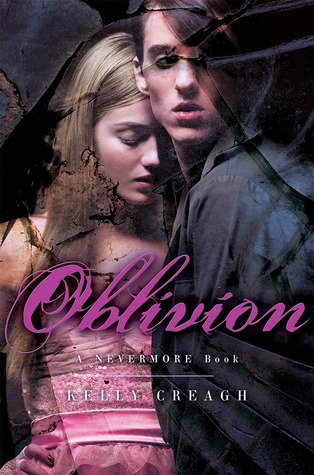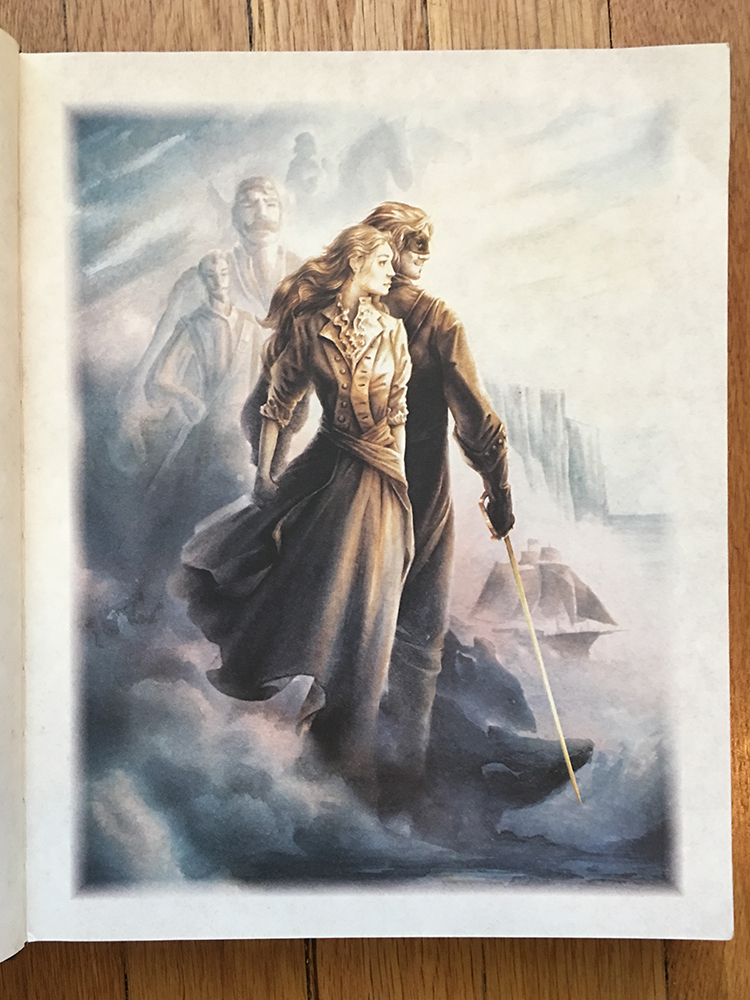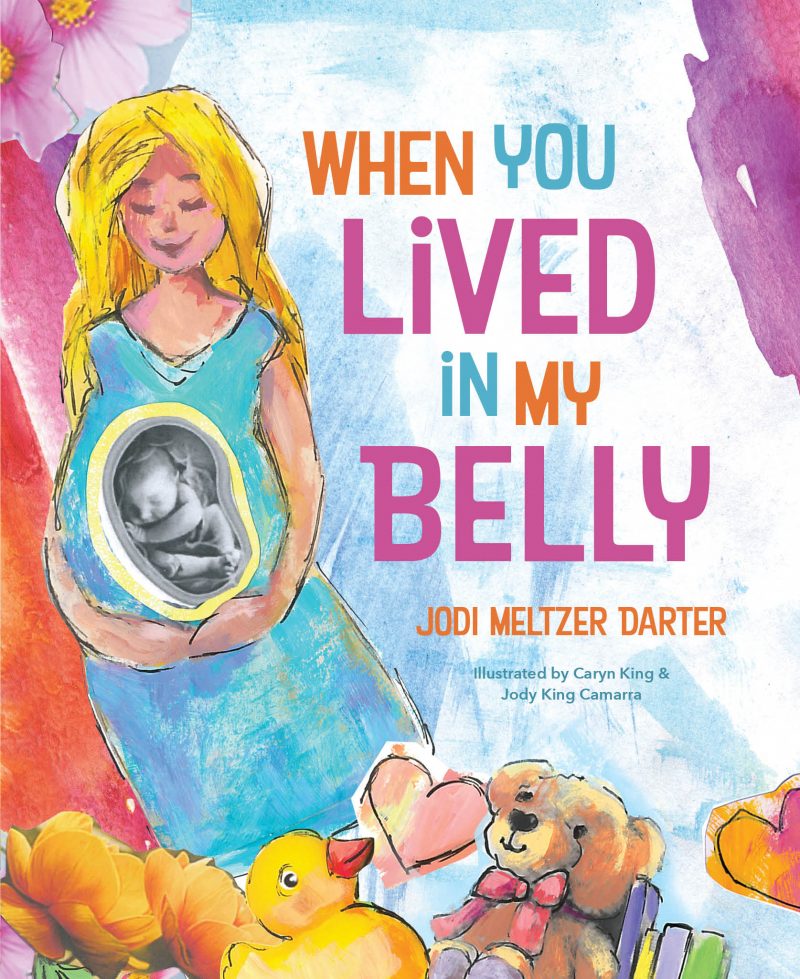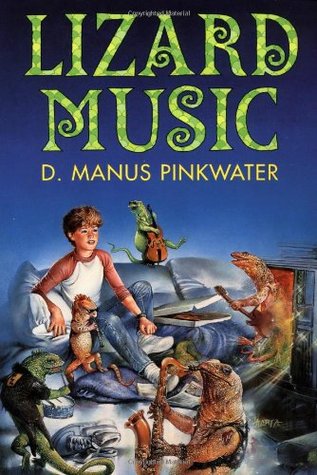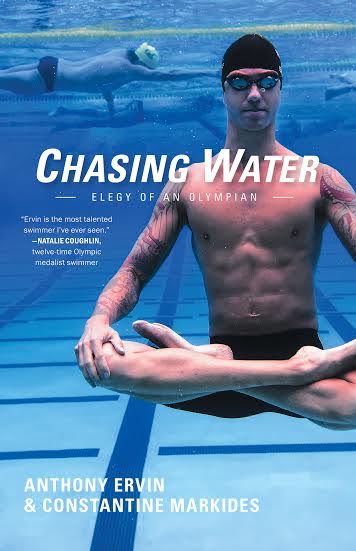A few years ago, my friend and fellow book lover Lauren dropped by my house, book in hand: “Kat – stop whatever you are reading, and read this instead.” She shoved a black book with pink accents in my hand, Nevermore by Kelly Creagh, and continued her diatribe while I read the back cover. “It’s about a goth and a cheerleader – and oh, that makes it sound trivial, but Kat – Poe. It features the work of Poe. You know how much I love Poe.” I indeed did know how much she loved Poe, so that evening I set out on a journey with Isobel Lanley, cheerleader extraordinaire. I finished the book in a matter of hours and desperately sought out the second novel, Enshadowed. I devoured that in a single day as well and then waited and waited and waited for Book 3, Oblivion, to arrive. That day finally came last week – and oh, boy, it was joyous.
As I mentioned before, the Nevermore trilogy by Kelly Creagh centers around a cheerleader, Isobel Lanley, and a goth, Varen Nethers, and what happens when they are randomly paired together for an English project – the subject being Edgar Allan Poe, naturally. Through a series of dreams, realities, tragedies, and triumphs, the story unfolds in mysterious and exciting ways, all within Creagh’s fictional world that expertly weaves Poe’s works throughout the narrative and exposition. It is near impossible to discuss the book without giving away major plot details, but I will do everything in my power to keep it spoiler free. If you haven’t read the first two Nevermore trilogy novels, Nevermore and Enshadowed, I strongly suggest that you skip directly to our interview with Kelly below!
After failing to retrieve Varen from the “other side” twice, Isobel is dead set on giving it one last attempt. She is the only one who knows that Varen isn’t dead (although intuitive friends are intuitive!) but that he is trapped and has been consumed by his own writing’s evil, wanton ways. Already skating on thin ice with her parents, Isobel teams up with “friends” Pinfeathers and Reynolds to delve into the nether and retrieve her love.
I most often read in the evening as a way to unwind, yet often found myself unable to read Oblivion after dark. Creagh creates a word where reality, dreams, and fantasy so often intermingle and meld into one that I was finding it difficult to continue once the Earth was covered in shadow and became still. There are moments of the book that are incredibly intense, and I would find myself holding my breath, waiting for the other shoe to drop, or for reality to become visible once again. It is hard to differentiate where Poe stops and Creagh begins; the two worlds and works of fiction play off each other incredibly well, often influencing each other without even forcibly trying. I am not familiar with a lot of Poe’s work outside of the well-known poems and as such would find myself researching a section or paragraph only to find that the work was original to Creagh and was indeed not Poe. An indication of full immersion into a subject, if you ask me.
The final third of the novel, the climax, is a rollercoaster of emotions that never slows down or ceases. Reality and dreams are nearly one at this point, and the imagery that Creagh creates is masterful. I often found myself re-reading passages to be sure that I had visualized the world correctly in my head. The details were many, the ideas and structures clear, and the outcome incredulous. There were many twists and turns, detours that the narrative took that I never expected, and that made it all the more exciting. Once the end arrived, I was sure I had figured out what went down, how everything finally came to be, but let’s just say that dreams often influence real life, and real life influences dreams. The hard part is telling them apart.

First question is a big one – Poe? You’ve spoken before about how when you started writing, Poe was less of a feature of more of a random choice made by Varen. Through your research, the story started to form. Can you speak to what it was about Poe and his tale that intrigued you?
I began writing Nevermore as more of an exercise. I was earning my MFA at Spalding University and working one-on-one with my mentor, Joyce McDonald (Shades of Simon Gray.) When I turned in the first chapter of Nevermore (which had no title at the time) Joyce encouraged me to continue with the project, suggesting it had a special spark. Really, all I had was the idea of a cheerleader and a goth being forced to work together on an English project. I knew my goth boy was a writer, and I also knew that the dark things he drew and wrote about in his sketch book would come to life. When I wrote the opening scene, I figured Poe would be a likely choice for my goth boy to suggest. At that time, I had no plans to make Poe a central focus. I thought I’d research Poe on a surface level, just to tie in some details. But then the weirdness set in. I discovered strange things about Poe’s life. But there was nothing more strange than the circumstances surrounding his death. He disappeared for five days and was found insensible in the street, wearing someone else’s clothing. He was taken to the hospital, where he spoke to invisible entities and, on the day before he died, began calling out for someone no one knew. Someone named Reynolds. To this day, no one knows how Poe died. There are over thirty theories. No one knows what happened to Poe during the days he disappeared, and no one knows who Reynolds was either. During my research, I also read about the figure known as the Poe Toaster. The Poe Toaster is a real man who, every year on January 19th—Poe’s birthday—sneaks into the locked cemetery where Poe is buried. Watched by a crowd of curious onlookers, The Poe Toaster delivers three red roses to the gravestone marking Poe’s original burial spot. The Poe Toaster then raises a glass of cognac to Poe in a toast and, leaving the bottle and the roses, disappears into the night. He wears a cloak, a black hat and a white scarf that covers half his face. Needless to say, all these strange Poe facts began to weave together in my mind and meld with the fiction I’d already begun to create. I thought, what if Poe fell into a dreamworld for the five days he went missing? What if he left clues in his poems and poetry as to what really happened to him? What if the same thing is happening again to my goth boy? What if the Poe Toaster and Reynolds are one and the same? At this point, Poe began to take over. His mysterious death became the backbone of the novel and my research became more intense. I went to Poe’s house and graves in Baltimore. I visited the Poe Museum in Richmond. I gathered the clues of his life and death and took inspiration from his stories. Also, I began to draw parallels between Varen and Poe. Varen’s name, for instance, is an anagram for Raven. My idea for one book grew into three, and weird Poe-related things began to happen. I even got a birthday card from the dead poet himself. That was back in 2007, way before the first book was under contract. It wasn’t even finished! The card featured a picture of Poe and, over his head, a thought bubble. Inside the thought bubble was a photo of me. “Thinking of you on your birthday,” the card read, and was signed “Your Biggest Fan, Edgar Allan Poe.” To this day… I still have no idea who sent it.
You use numerous real Poe works in your fiction to help tell the tale, both as narrative and through the character’s themselves. Are there any poems that you wanted to try and use, but weren’t able to make work within the world?
I actually use a lot of Poe’s works! Many of his most famous poems and stories appear in some aspect. Some are way more obvious than others. The Masque of the Red Death, for example, plays a pivitol role in Nevermore. The Fall of the House of Usher is a major influence in Enshadowed, while the poem Annabel Lee plays a prominent role in Oblivion. But if you look at one of Poe’s lesser known works like my favorite, William Wilson, you’ll begin to see similarities in theme and subject. Also, smaller details appear. For example, Varen’s best friend, a bookshop owner named Bruce, has a glass eye. This was meant to be reminiscent of the old man with the vulture eye in The Tell-Tale Heart. At the end of Nevermore, a small jester appears briefly in one scene, and only fans of Poe would know this is his character Hop-Frog from his tale of the same name. But you don’t have to be familiar with Poe’s works to enjoy Nevermore. As I constructed the books, I wanted them to work in such a way that they would enrich a reader’s experience of Poe. If someone, for example, goes to pick up Poe’s story The Imp of the Perverse, or Ulalume, or Annabel Lee or Ligiea, I hope they’ll read it with fresh interest, a unique perspective and a deeper understanding if they’ve read my trilogy. I never tried to force any of Poe’s works in, though. If the opportunity didn’t present itself, I didn’t worry about it. I mostly wanted to encompass the overall themes of his writing—the themes of death, beauty, dreams, fear, longing, sorrow, aloneness and love.
In a world full of stereotypes, judgment, and social inequality, stories such as yours – a cheerleader falling for a Goth – seem to be the minority. Did the characters evolve into their respective niches and stories, or did they end up pretty much where you expected them to upon start?
It was really important to me, when I began writing Nevermore, to represent both my cheerleader and my goth with accuracy. There are so many stories about snotty cheerleaders out there. They really have a bad rap. And there are stories about the creepy weirdo kid, too. Frustratingly, I find that these stories play on (and play up) the stereotypes rather than challenge them. I wanted my story to be different. Actually, I wanted the battle of Isobel’s and Varen’s differences and the unraveling of their misperceptions of one another to be the soul of the story.
While I had the benefit of having known several goths personally in high school and in college, I didn’t know a lot about cheerleading. So I contacted my alma mater and asked to sit in on cheerleading practices. I talked to cheerleaders and watched countless stunt videos on YouTube. I did a lot of book research on cheerleaders, too. And now? It’s totally my favorite sport! You have to work hard to be a cheerleader. You have to be brave and gutsy, too. The hours are long, the training intense. I also loved that cheerleading became a major component of Isobel’s character. Being a cheerleader is tied in with her identity, and I think that helped to make her strong.
When it came to Varen, I knew I had a unique opportunity to bring my readers close to someone who is part of a subculture that is often misunderstood. I knew the things people automatically assumed about goths because that was the crowd I hung out with. Goths are often labeled as being depressed, tortured, unstable and dangerous. I wanted to bring light to that subculture. Speaking of Varen, it was also important to me that he didn’t come off as the typical male love interest. Varen isn’t some strapping guy with snappy hair. He’s tall, thin and pale. He’s quiet and reserved. But he’s mysterious, too. Very smart. But also sarcastic with a biting tongue. And an even sharper pen.
He isn’t want Isobel expects. But then, she proves to be far from what he expects, too.
Some of my favorite scenes in Nevermore were putting these two characters in a room with one another and letting their judgments fly. And then letting the two of them slowly figure out that they’re both wrong.
Your story is an intricate web, changing and morphing into something that is quite exquisite. What is your process like? Are you a fly by the seat of your pants author, or more like JK Rowling and plan it out, detail by detail?
I have become more of a planner and a plotter. Where Nevermore is concerned, though, I didn’t do any heavy outlining. I had ideas for plot points, and I always had narrative moments I was working toward, but it was all very fly-by-the-seat-of-my-pants. That worked for Nevermore and I still believe that my subconscious is a far better organizer than my conscious mind. The characters of Pinfeathers and Scrimshaw, for instance, were both complete surprises to me. When they appeared on the page though, previous scenes in Nevermore began to make total sense to me. For me, there’s a magic to those moments that I miss if I try to over organize my story. Their sudden manifestation on the page gave me great ah-ha moments. I know that Rowling plotted out the whole HP series. Now that I’m rereading them, I’m in awe of how no detail, no matter how small, is ever wasted. Every story thread has an ending, and the tapestry is both awe-inspiring and utterly flummoxing. I’ve definitely taken a leaf out of her book when it comes to planning, though I don’t do it to the detailed extent that she does. Or I haven’t yet. I couldn’t see that far ahead and, if I had tried, I’m not sure I would have gotten some of my favorite moments, like Isobel and Pinfeather’s dance, or Brad and the Red Death. Or Isobel and the grave. All of those moments sprang up out of the ether. I enjoy that spooky component to what I do. One thing I did pick up from Rowling, though, is the dropping of little Easter Eggs. If you look very hard, you can find them. The last four digits of Varen’s phone number, for instance, unscramble to Poe’s death date. There are tiny things like that sprinkled throughout.
Reynolds – have you ever met him?
No one knows who the real Reynolds was. I had great fun, however, tying the lore of Reynolds in with the legend of the Poe Toaster, though, and I did manage to catch a glimpse of him. In January of 2009, on Poe’s bicentennial, I went to Baltimore to join the crowd that gathers on the street to watch for him. I did manage to catch a very (very) brief glimpse of him as he darted between tombstones. And I was extremely lucky that I did, as that was the last year he was officially seen. No one knows what happened to the Poe Toaster, who has been observed visiting Poe’s grave since 1949. If you read Oblivion, though, you might gain some answers as to what might have happened to him.
You are a self professed Potterhead! What influence did JK Rowling have on your life? Your style? Your plot?
I am such a Potterhead. Reading Harry Potter was what made me want to become an author. Or, I suppose, it was the story that made me realize I already was a writer. Writing was what I did in my spare time, it’s what I did for fun. But reading Harry Potter gave me the guts I needed to take the next step. I applied for grad school because of Harry Potter and I learned a lot about plotting and story just by reading J.K. Rowling’s work. I’m indebted to the story—to Rowling. In more ways than one! Rowling’s books opened the market for more middle grade and young adult works. By the time I started to submit my manuscript, the teen market was booming and more people were reading YA than ever before. A lot of the credit there, I believe, goes to J.K. Rowling. Just the way she handled story has been so influential to me. Her world-building is so rich it’s real. So rich it had to be real! And now there’s a theme park. To say she is in inspiration is an understatement. She’s my hero.
Pinfeathers, the dark side of Varen, could easily be compared to the Dementors in the Potter series. JK Rowling has spoken often about how they reflect her deepest days of depression, and how that was a way for her to work through it. Is there any character or situation in the series that reflects directly back on you such as this?
The Nocs are inspired by Poe’s short story “The Imp of the Perverse.” In that story, the narrator states that the imp of the perverse is the part of you that wants to do the wrong thing just because it is the wrong thing. The Nocs represent the self-sabotaging part of the self. But, the Noc’s are also Varen’s deepest desires brought to life. Some of those desires are admirable. Some…not so much. All of them are conflicted. So the Nocs were quite fun to write. I think everyone has Nocs, myself included. They also represent that malicious little voice in your head that tells you that you can’t do something, or says awful things about you. For Varen, those voices are loud. For me, sometimes they’re loud, and sometimes they’re quiet and easily squashed. During the writing of Enshadowed, my Nocs were loud and raucous. They got the better of me on most days. Though they still come back to taunt me, having completed a trilogy certainly has made it easier for me to disperse them. Unlike the Dementors though, I’m not sure that the Nocs ever completely go away. Like the dementors however, they have to feed to be strong. So, I try my best these days not to feed the Nocs.
Let’s sort some characters into Hogwarts Houses. Isobel. Varen. Gwen. Bruce. Danny. Poe.
Isobel is such a Gryffindor. She’s brave but impulsive. She’ll ditch the rules and go with what her heart is telling her is the right thing to do. She’s competitive and headstrong. Stubborn, too. Gryffindor all the way.
Varen? Well, many Nevermore readers who are also potter fans assume Varen is a Slytherin. I can see why they might think this. He’s cunning and quiet. He’s calculating. He isn’t what I would call shrewd, though, and he shies away from the limelight. He’s driven by his passions but not achievement itself. He has a thirst for knowledge, and a keen interest in the arts. He’d rather spend an evening writing or drawing than socializing. He’s an excellent student and a quick study. He hides his strengths, though. Because they are often attacked. Ironically enough, taking that into consideration, his strengths are also his weaknesses.
Gwen is tough. I think I would place her in Gryffindor. But I imagine the sorting hat would seriously consider Ravenclaw. In the end, though, I think she’d be a Gryffindor. For her, friends and family come first. She’s braver than she knows. She tells it like it is and she’s not afraid to speak up. Even if she’s inappropriate. Or sometimes overshares.
Bruce would be a Ravenclaw for certain. Books are his passion—knowledge, too. His earlier days might have been more in line with those of a Gryffindor, but his true love is for words and those who write them. He and Varen make a good team.
Danny, Isobel’s little brother, is a Slytherin. He is shrewd. He’s a little businessman, and often shocks Isobel with his level of cunning. Particularly when it comes to negotiating. He calls Isobel out on stuff, but he’ll also help her in a pinch. He sees things that escape the notice of Isobel and Varen’s parents. He’s ambitious when it comes to getting what he wants. But he’s still a good little brother. Even if he’s not above taking revenge here and there. Or charging for silence.
And Poe is a total Ravenclaw. And not just because of the name! He might actually be the Raven-est Raven that ever clawed. Knowledge was a major pursuit for Poe. He was a stellar student and, when it came to academics and literary achievements, he was fiercely competitive. He might have had some Slytherin tendencies, though. He was a fierce literary critic—the Simon Cowell of his day. And if you crossed him, it was his wit against yours. Never a good thing, since Poe was adept at puzzles and the father of the modern mystery tale. He also had a great sense of humor and in his younger days he was known as a great practical joker. So he would be a Ravenclaw—though a very complex one.
What’s next?
Oh, I have so many cool projects I’ve been working on, though nothing under contract. My favorite one is the strangest thing I’ve ever written, but also the most fun. It’s a story I think Potter fans in particular would love as there’s a lot of world-building and unique magic and non-magical characters. There’s also a modern fairy-tale feel to the book. The proposal has been turned down a couple of times for being too different. I don’t let that that detour me, though, because everyone who has seen the project is in agreement there isn’t anything like it out there, so I know that’s a major advantage. I’ve just got to get the novel under the right pair of eyes. In the meantime, I’ve written a contemporary YA fantasy adventure about a bellydancing teen girl, a Muslim American boy and a fugitive Djinni. Currently, I’m working on a paranormal romance similar in tone to Nevermore but very different, too. This time, the background focus is on another famous figure from history who, like Poe, died under strange circumstances. Circumstances involving a famous spiritualist medium, séances, a dark curse, a mischievous spirit, and a Halloween death. The figure in question? Another magician who shares the name Harry.[/toggle]

